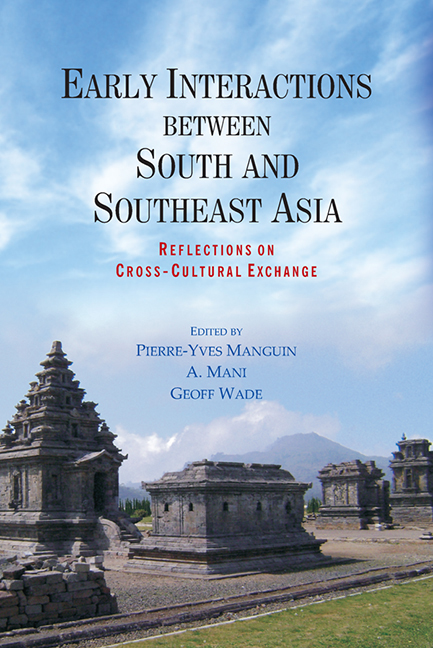Book contents
- Frontmatter
- Contents
- FOREWORD
- Preface
- Introduction
- PART I New Archaeological Evidence from South Asia and Southeast Asia
- PART II Localisation in Southeast Asia
- 11 Tamil Merchants and the Hindu-Buddhist Diaspora in Early Southeast Asia
- 12 The Spread of Sanskrit in Southeast Asia
- 13 The Early Inscriptions of Indonesia and the Problem of the Sanskrit Cosmopolis
- 14 Indian Architecture in the ‘Sanskrit Cosmopolis’: The Temples of the Dieng Plateau
- 15 The Importance of Gupta-period Sculpture in Southeast Asian Art History
- 16 Individuals under the Glaze: Local Transformations of Indianisation in the Decorative Lintels of Angkor
- 17 Early Musical Exchange between India and Southeast Asia
- 18 Buddhism and the Circulation of Ritual in Early Peninsular Southeast Asia
- 19 Early Buddhism in Myanmar: Ye Dhammā Inscriptions from Arakan
- 20 Hindu Deities in Southern Vietnam: Images on Small Archaeological Artefacts
- 21 ‘The Depositing of the Embryo’ – Temple Consecration Rituals in the Hindu Tradition of South and Southeast Asia: A Study of the Textual and Archaeological Evidence
- 22 Localisation of Indian Infl uences as Refl ected in the Laotian Versions of the Ramayana
- 23 Broken Threads: Contested Histories of Brahminism in Cambodia and Thailand and the Construction of Ritual Authority
- LIST OF CONTRIBUTORS
- INDEX
21 - ‘The Depositing of the Embryo’ – Temple Consecration Rituals in the Hindu Tradition of South and Southeast Asia: A Study of the Textual and Archaeological Evidence
from PART II - Localisation in Southeast Asia
Published online by Cambridge University Press: 21 October 2015
- Frontmatter
- Contents
- FOREWORD
- Preface
- Introduction
- PART I New Archaeological Evidence from South Asia and Southeast Asia
- PART II Localisation in Southeast Asia
- 11 Tamil Merchants and the Hindu-Buddhist Diaspora in Early Southeast Asia
- 12 The Spread of Sanskrit in Southeast Asia
- 13 The Early Inscriptions of Indonesia and the Problem of the Sanskrit Cosmopolis
- 14 Indian Architecture in the ‘Sanskrit Cosmopolis’: The Temples of the Dieng Plateau
- 15 The Importance of Gupta-period Sculpture in Southeast Asian Art History
- 16 Individuals under the Glaze: Local Transformations of Indianisation in the Decorative Lintels of Angkor
- 17 Early Musical Exchange between India and Southeast Asia
- 18 Buddhism and the Circulation of Ritual in Early Peninsular Southeast Asia
- 19 Early Buddhism in Myanmar: Ye Dhammā Inscriptions from Arakan
- 20 Hindu Deities in Southern Vietnam: Images on Small Archaeological Artefacts
- 21 ‘The Depositing of the Embryo’ – Temple Consecration Rituals in the Hindu Tradition of South and Southeast Asia: A Study of the Textual and Archaeological Evidence
- 22 Localisation of Indian Infl uences as Refl ected in the Laotian Versions of the Ramayana
- 23 Broken Threads: Contested Histories of Brahminism in Cambodia and Thailand and the Construction of Ritual Authority
- LIST OF CONTRIBUTORS
- INDEX
Summary
INTRODUCTION
Excavation and restoration works conducted on ancient sites of Southeast Asia brought to light numerous miscellaneous objects installed at different locations inside the walls or in the foundations of ancient temples. These objects include precious and semi-precious stones, figures cut out of gold leaf, fragments of metals, inscribed metal sheets, grains and seeds, often enclosed in containers, such as jars or boxes. The number of excavated containers and stray objects is very high. In the course of my research I could trace over one hundred such finds originating from the temples of Southeast Asia. But their number is certainly higher as not all finds have been documented.
The excavated objects have been mentioned in a number of publications, mainly in the archaeological reports. Yet, there was, until present, no publication in which all the information about these finds could be gathered and analysed as a group. Consequently, no satisfactory explanation of the function and meaning of these finds could be given. A few scholars (see, for example O'Connor 1966 and Mitra 1981) suggested a connection between one or other specific finds and temple construction ceremonies. But no thorough study on this subject was ever conducted. The hints as to how to interpret the excavated objects cannot unfortunately be found in the very regions where the objects were discovered. In Java, Cambodia, Malaysia and Vietnam, where the majority of the objects were found, the indigenous manuals on temple architecture and temple building rituals either did not exist or did not survive. The surviving textual sources – the literary works of Java or Cambodia and the inscriptions – do not mention such objects or their installation within temples.
THE ARCHAEOLOGICAL FINDS
Among the objects unearthed from ancient monuments of Southeast Asia, at least two types can be distinguished on the basis of shared characteristics. The first type consists of cubical containers divided into a fixed number of regular compartments. Inside these compartments were found numerous small items, such as those listed above, namely semi-precious stones, figures cut out of gold leaf, grains, and so on. The second type consists of four bricks and a number of miscellaneous items. At the moment of discovery, the four bricks formed a square and the small items were lying in the middle of them.
- Type
- Chapter
- Information
- Early Interactions between South and Southeast AsiaReflections on Cross-Cultural Exchange, pp. 433 - 442Publisher: ISEAS–Yusof Ishak InstitutePrint publication year: 2011



